#baksei chamkrong
Explore tagged Tumblr posts
Text

Prasat Baksei Chamkrong, a small Hindu temple in the Angkor complex, Cambodia
French vintage postcard
#cambodia#baksei#historic#photography#postal#hindu#ansichtskarte#angkor#small#photo#sepia#temple#vintage#postcard#prasat#briefkaart#chamkrong#postkarte#tarjeta#carte postale#ephemera#prasat baksei chamkrong#postkaart#complex#french
3 notes
·
View notes
Text

We have seen plenty of reports about people who are shocked or even dismayed by having gone though a transformation at The Celestial Temple of Harmony, Beauty and Repose Salon.
But what about those delighted by them or those who sought The Temple out?
Below are some of those.

Here we have Amelia Pugh, who was a huge fan of all things Nippon, Anime, tea ceremony, fashion, you name it.
So much so that almost every one she knew gave her a hard time about it.
Now as Amay Yuki it’s all just everyday life. Though some in her new home on Osaka wonder still kind of Mid-Western American accent, but she is working on it.

Mina Richardson had always had a great interest in the ancient sights of Cambodia, such as To Prohm, Preah Khan, and Baksei Chamkrong.
Now that we have made her into her new self known as Ritharavong Mealea, she not only can easily visit them, she lives just 7 km from her favorite one Banteay Kdei.

Julia McDonald of Huntsville, Alabama liked kimchi a LOT, even if it didn't quite fit into Southern cooking.
However, as Jinju Kim in South Korea it's a way of life for her now.

Lawyer for a prestigious law firm in Boston, Amber Gill found that it was none stop stress, so much so that the high-end designer mixed drinks she drank on "lunch" were starting to become to much of a thing for her.
Now as Filipina woman, Andie Nicelle Dela "Gigi" Somera she can at last relax and never bothers with anything fancier than a local Red Horse Beer from time to time.

Chicago redhead Paige Clark read a lot about Chinese culture, a lot,.
Now as a resident of Hong Kong known as Wing Pang Cao “But everyone call me Paige I like the sound of that.” she can really soak it in.
7 notes
·
View notes
Text
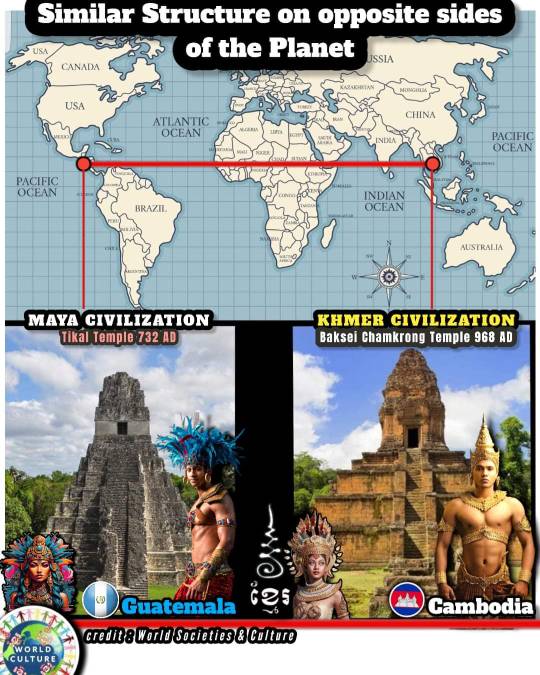
O Mapa Mundi como estamos acostumados ver , estas duas construções. Mesmo distantes, possuem características construtivas bem semelhantes.
● Templo de Tikal está na Guatemala,
● Templo Baksei Chamkrong: um templo hindu localizado no Camboja.
A ciência atual considera o tempo de construção na ultima era, ou seja, depois da última era Glacial.
Quem conheceu a história da Lemúria, sabe que esse grande continente ficava no Pacifico. Nese tempo, esse continente era habitado por por nós e no auge do nosso desenvolvimento como civilização organizada, recebemos a Luz do conhecimento com os primeiros informes sobre a Lei de comportamento. Já foi publicado na grande mídia a existência de grandes construções humanas submersas nas proximidades do Japão. A ciência através dos estudos geológicos nos ensinou oficialmente que o planeta tem uma idade de bilhões de anos e que ocorre mudança geológicas causadas por mudanças geomagnéticas. Continentes se separaram ou desapareceram sob os oceanos, formando novas porções de terra e os períodos podem variar entre as mudanças. Algumas escrituras nos informa que essas alterações do magnetismo da Terra é de aproximadamente 12 mil anos.
Há muito pouco material que segue essa linha de pensamento, registrada nos arquivos de história guardados nas regiões espirituais mais elevadas do nosso orbe. Como um livro de história, essas construções encontradas por todo o planeta são apenas a "capa" e a Revelação, através do intercâmbio entre os planos é o "miolo" desse livro.
Há um paralelo que precisa ser mensionado. Sempre que ocorre uma grande mudança geológica em nosso planeta, não por acaso, a humanidade daquela civilização se encontra decadente, moralmente falando, e estão encarnados para terem uma ultima chance de evolução. Quem não conhece a história de Sodoma, destruída por um cataclismo climático? Mas dessa vez, os condicionantes da nossa mudança atual, é de um ciclo maior, que levou aproximados 540 mil anos, onde ocorre as migrações, quem não alcançar as condições mínimas para permanecer, será transferido para um planeta mais atrasado evolutivamente, um choque de realidade.
Créditos de imagem: "Sociedades Mundiais e Cultura".
2 notes
·
View notes
Text
Prasat Baksei Chamkrong is located 150 meters north of Phnom Bakheng and 80 meters from the road leading to the south gate of Angkor Thom. It was built in 948 for god shiva in Hinduism. Temple is still in good condition until now.
youtube
0 notes
Text
Living Vicariously Through the Naga:The Enigma Lives On in Siem Reap…
by: Genie
Ensconced in the rainforest and steeped in centennial mythology, lies the province of Siem Reap, home to the variegated archaeological extravaganza embodied by Angkor, the old seat of the Khmer Empire. Once shrouded in mystery, this verdant area is dotted far and wide with architectural wonders, however a particular quartet of magisterial temple complexes, open to the public today, accounts for much of its widely deserved mystique: Angkor Wat, Angkor Thom, Preah Khan and Ta Prohm.

The historical promenade through Cambodian history could not begin at a better place than Angkor Wat. After a brisk, vertiginous walk over the frontal moats and their tall lily pads by way of the “floating” bridges, Angkor Wat starts etching its “mountainous”, verdigris contours on the horizon, in all its pomp and pageantry. Some tall palm trees here and there, wandering rhesus monkeys, endless meters of loggias reflecting over the water, and monks clad in orange walking back and forth, act as merely the castellated gateway and battlements to King Suryavarman II’s main, multi-story building and its five signature turrets set against a perennial twilight sparkle.

Given the magnitude of this World Heritage structure, it would take more than one afternoon to visit it properly. Suffice it to say, to this day Angkor Wat is the largest standing religious building in the world. Still and all, its essence is to be found primarily in a threefold enigma. First of all, it is per se rather puzzling that Angkor Wat should be originally consecrated to none other than the Hindu divinity Vishnu. Today, Angkor Wat is both Hindu and Buddhist, but considering that Hinduism is not as geographically widespread as Buddhism from India eastwards and that it is an older religious philosophy, it begs a more in-depth question as to what exactly happened. Hence, the (originally and equally) Hindu Ko Samut Teuk Dos legend, also known as Samudra manthan (in Hindi); in other words, The Churning of the Ocean of Milk.
According to this founding epic, Devas (Gods) and Asuras (Demons) were forever at war to dominate the world. Ever more tired and running out of strength, the Devas asked Vishnu for help. As a token for his help, Vishnu asked the Devas to search for Amrita, the Sacred Elixir of Immortality, from the depths of the cosmos. However, because the task was so difficult, the Devas were forced to ally with their antagonists, the power-voracious Asuras. Using Mount Meru as the pivotal point and the King of the Nagas (snakes), Vasuki, as a churning device, both factions placed themselves at different extremities of the Naga and started pulling, while many treasures emerged from the Ocean of Milk. In time, the Asuras, being closer to the head of the Naga, were eventually poisoned by the fumes it exhaled, only managing to save themselves when Amrita was delivered to them by a divinity emerging from the Ocean of Milk. This episode did not go unnoticed by the Devas; they promptly informed Vishnu, who managed, in turn, to steal back Amrita and hand it to the Devas, so that they could reign supreme and banish the Asuras to hell.

This legendary tale represents the second enigma of Angkor Wat, and is virtually “unlocked” in the impossibly beautiful bas-reliefs stretching along the 49 meters of the east gallery, a grand spectacle where what could have been remnants of muted pink, ochre, and terra-cotta hues can still be slightly discerned by the naked eye between carvings. Also unlocked within Angkor Wat is the third enigma, whereby a Naga princess wed the First King of Ancient Cambodia, giving rise to the Cambodian people or Khmer. In this respect, Angkor Wat has various massive balustrades in the shape of the seven-headed Naga, each head representing the seven “races” of the Naga people. A recurring theme in the Angkorian temples, the seven-headed Naga is part and parcel of Khmer cosmology, as are the Apsaras, the celestial dancing creatures whose main purview included entertaining royalty and divinities on earth with their perfunctory expressions.

The hypnotic tour through Khmer chronology continues between Angkor Wat and Angkor Thom, where a short pit-stop to the Baksei Chamkrong temple gives us a taste of what would seem to be yet another enigma. According to various “conspiracy” theories, there are uncanny stylistic similarities between the Mayan Pyramid of the Great Jaguar (in Tikal, Guatemala) and Baksei Chamkrong! Clearly, the knowledge and discoveries acquired thus far on the matter are not enough to reframe history, so to say; nonetheless this testament to the universal aspect of human imagination makes for some quite fascinating journeys!
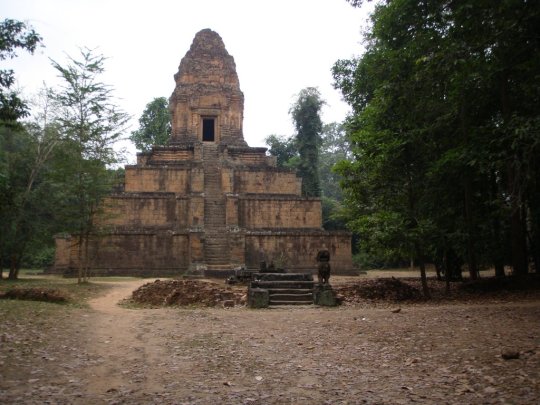
On its part, Angkor Thom, the last capital city of the Khmer Empire, boasts a masterpiece triad of its own, the first of such being King Jayavarman VII’s exquisite 350-meter long Terrace of the Elephants. Once a royal platform to salute his military forces, this terrace features intricate carvings of lions, elephants and Garudas, the bird-like creatures pertaining to Hindu, Buddhist and Jain mythology, and stalwart nemesis of the Nagas. Located just off the Royal Square is the Terrace of the Leper King. Although there was a king with leprosy in Cambodian history, the name derives mainly from the erosion found on the statue of Yama, the God of the Underworld, carved within this site. This terrace might have been used for funerary/cremation rites.

Perhaps the most distinctive temple in Angkor Thom is the “baroque” Prasat Bayon. Entering through the South Gate, one is confronted with nothing short of yet another enigmatic vision, as 200 towering giant faces (four per tower) look down on you with their seraphic smiles and sphinx-like countenances. Although it is unclear whether the faces depict Lokesvara (the Buddhist bodhisattva of compassion) or King Jayavarman VII, the two hypotheses do not necessarily exclude each other. While the bas-reliefs within the temple, portraying military scenes and other mundane events, are also worthy of note, the deeply rooted “intimidation/awe” deriving from the “scoping stares” remains the main highlight of the Bayon. For all we know, they might have been –and still are- quite a bulwark against the evil eye, if anything!


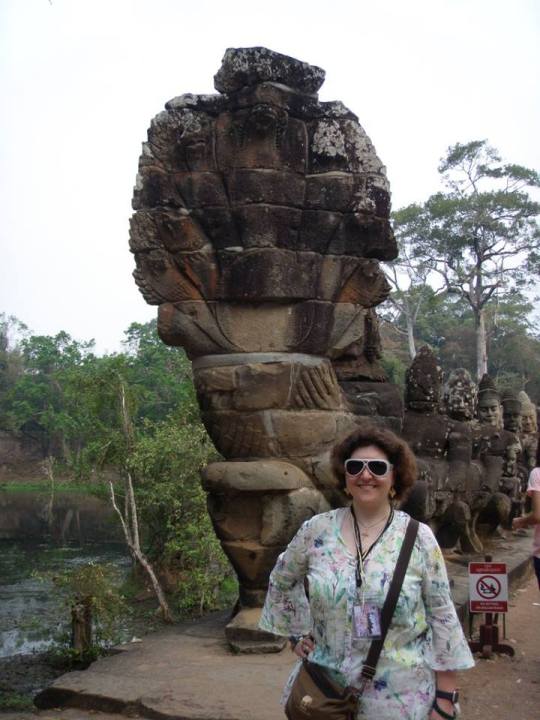
The eternal voyage of the Naga continues in the Neak Pean and Preah Khan temples, located north of Angkor Thom. Upon first impressions, and having to cross a long walkway on swampy waters before reaching the former, it is hard to believe that there might be a temple at the end of the glittering trail. However, Neak Pean juts out from a central sacred pool (believed to represent the mythical Lake Anavatapta and to have healing powers), surrounded by two “underwater” sculptures of the Naga. As regards the latter temple, it is the proof that nature (usually) claims –or ravages, in this case- back its own! At any rate, not even this inevitable and “vengeful” predicament has managed to cover up the ineffable magic of Preah Khan, home to Jayadevi (a sister-wife of King Jayavarman VII), among others. Moss, lychen and ferns slowly brush over the rubble and rickety beams framed by quasi-trompe l’oeil flourishes, while a vast array of delicate carvings, reliefs and friezes, not to mention the standing library ruins and stupa illuminated by the sun, complete this eerie, albeit paradoxically idyllic, setting on the green.
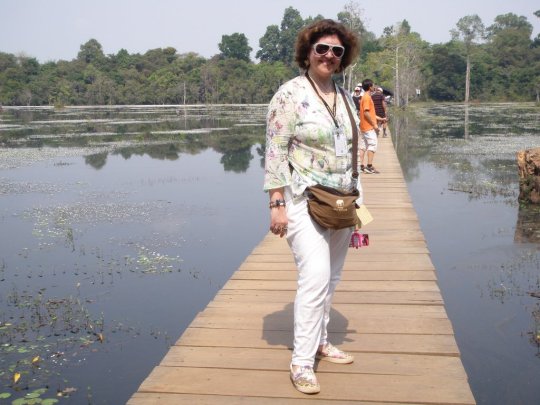

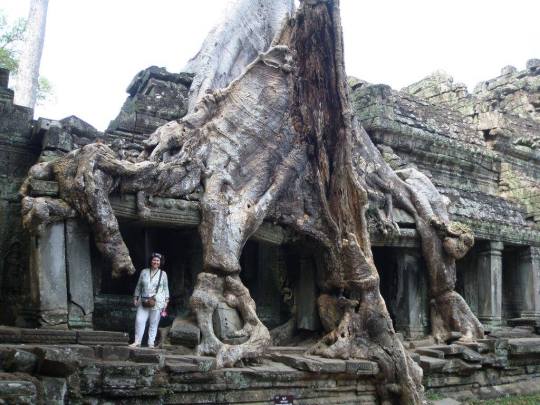


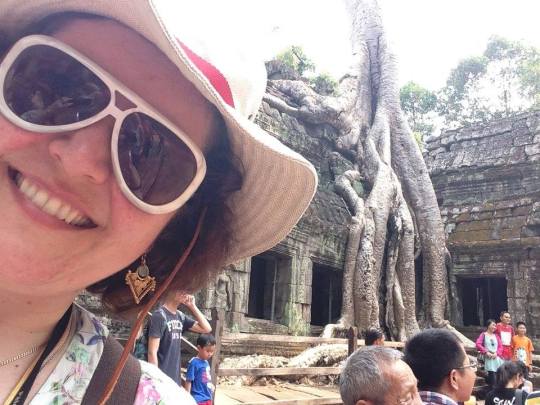
The encroaching nature and weathered look of Preah Khan, however, is solely a prologue to the real devouring power of the forest subsequently witnessed at Ta Prohm, the culminating phase of this open-air museum survey. As soon as Ta Prohm’s ruins are approached, the elusive footpaths give way to a stunning portrait of luxuriant foliage and creeping vines that lift as if they were deep-green shutters following each occasional waft of wind. Here, the Nagas and Apsaras have relinquished their leading roles to the true main protagonists, tetramelacea (tetrameles nudiflora), ficus strangulosa and ceiba pentandra (kapok), names that, given their peculiarity, would seem those of gods, but actually refer to gigantic trees. Their imposing barks have literally taken over the temple complex, coiling up the ruins like the Nagas themselves… or is it that the trees are living vicariously through the Nagas and viceversa? Alas, not even Lara Croft could have possibly deciphered this last enigma, bound to live on for the centuries to come! But, like Lara Croft’s alter-ego, we shall return…
Rome, 5 March 2019
#cambodia#viaggidellelefante#khmerempire#khmertemple#siemreap#angkor#angkorwat#angkorthom#baksei chamkrong#neak pean#prasat bayon#preah khan#ta prohm#apsara#naga#vasuki#samudra manthan#lara croft#tombraider#tomb raider#kapok#tetramelacea#suryavarman#jayavarman#jayadevi#anavatapta#terrace of the elephants#terrace of the leper king#garuda#hindu
12 notes
·
View notes
Photo

Сиемреап, Камбоджа
Chowe | Фотография | Карта
#путешествия#фото#русский блог#Камбоджа#русский тамблер#Сиемреап#русский тумблер#Сием Рип#по-русски#Chowe#Siem Reap Province#Krong Siem Reap#Cambodia#Sangkat Kouk Chak#Siem Reap#Temple#Pyramid#Hindu#Baksei Chamkrong#Angkor Archaeological Park
1 note
·
View note
Photo

Baksei Chamkrong temple, Angkor, Cambodia
80 notes
·
View notes
Photo

Siem Reap#8 - Baksei Chamkrong
0 notes
Photo

Siem Reap#8 - Baksei Chamkrong by ewhchow
0 notes
Photo

at Baksei Chamkrong I ប្រាសាទបក្សីចាំក្រុង https://www.instagram.com/p/ChNLM7EvHAB/?igshid=NGJjMDIxMWI=
0 notes
Photo

Exercise by climbing up, offer prayers and gratitude, a gentle morning light for the freckles, and with the arms akimbo for that confident attitude and I am set for the day. Baksei Chamkrong, Siem Reap. Dec 2018. Note8. TY to Ruben for staying at the front to take my photo. (at Baksei Chamkrong) https://www.instagram.com/p/CXaz4yxpyI8/?utm_medium=tumblr
0 notes
Link
Hey guys, இன்னிக்கி Cambodiaல இருக்கற Angkor Watல Baksei Chamkrong அப்படின்ற ஒரு வித்யாசமான இடத்த பத்தி தான் பாக்கப் போறோம். இந்த கோவில்ல படி எல்லாம் வச்சு pyramid shapeல, அதாவது stepped pyramid மாறி இருக்கற ஒரே structure இது தான். Cambodiaல இருக்கற இந்த pyramidம் Mesoamericaல கண்டுபிடிச்ச pyramidம் பாக்கறதுக்கு ஒரே மாதிரி இருக்கு. அங்க இருக்க பிரமிடோட பேரு Tikal..
- பிரவீன் மோகன்
0 notes
Photo







| Jour #4 | Juste avant la porte pour Angkor Thom, le temple hindouiste Baksei Chamkrong. Une belle surprise à apprécier entre nous. Période : début Xème siècle
1 note
·
View note
Text
Angkor Archaeological Park

Most commonly known for Angkor Wat, the archaeological park is located just outside of Seim Reap in Cambodia. The sprawling compound built in the 9th century A.D. is home to 1,000+ temples and structures that make up this popular tourist destination. 2 million visitors make the trek to Seim Reap to visit the ruins; The 37 USD entrance fee and with impressive tourism numbers have provided a revenue stream to preserve and restore the temples. Sadly, most temples have some level of destruction due to natural disasters, looting, and nature doing nature-things. Some of the famous temples and sites in the archaeological park: Angkor Thom Angkor Wat Baksei Chamkrong Banteay Kdei Banteay Samré Banteay Srei Baphuon the Bayon Chau Say Tevoda East Baray East Mebon Kbal Spean the Khleangs Krol Ko Lolei Neak Pean Phimeanakas Phnom Bakheng Phnom Krom Prasat Ak Yum Prasat Kravan Preah Khan Preah Ko Preah Palilay Preah Pithu Pre Rup Spean Thma Srah Srang Ta Nei Ta Prohm Ta Som Ta Keo Terrace of the Elephants Terrace of the Leper King Thommanon West Baray West Mebon ANGKOR ARCHAEOLOGICAL PARK UNCENSORED Visiting Angkor is a multi-day excursion; however, a full day trip allows you to see most of the popular points of interest. Getting to Angkor Archaeological Park is easy as tour drivers and guides are available in town and at any hotel. Read the full article
0 notes
Photo

Heading out of the main temple complex at Ankor Thom I couldn’t resist capturing a few night shots of Baksei Chamkrong Pyramid. My driver explained it was to dark and impossible to see the temple now. While it was almost completely hidden in the darkness to the naked eye a little bit of luck and this appeared. I even garnered a gasp from my driver when he saw the screen. The days shooting rapidly ended as security guards caught a glimpse of the torch light and kindly escorted us back out of the jungle. #nightphotography #architecture #arkitektur #ancientarchitecture #jungle #bakseichamkrong #sonyalpha (at Angkor Wat Temple-ប្រាសាទអង្គរវត្ត) https://www.instagram.com/p/B9hLFDVpzFu/?igshid=1gzsjdeet23t7
0 notes
Text
Cambodia: The Temples of Angkor - Approach Guides, Jennifer Raezer & David Raezer
Cambodia: The Temples of Angkor Travel Guide to Angkor Wat, Angkor Thom, Bayon, and More Approach Guides, Jennifer Raezer & David Raezer Genre: Asia Price: $8.99 Publish Date: January 20, 2019 Publisher: Www.approachguides.com Seller: Approach Guides LLC RECENTLY UPDATED FOR 2019 ! With insightful profiles for 23 of Angkor's top temples and nearly 200 high-resolution images, this is the definitive travel guide to Angkor, Cambodia's premier World Heritage destination. Angkor — the capital of the Khmer empire that thrived for 500 years from 802-1327 — is one of the most magnificent sites in Southeast Asia. The ancient city’s temples inspire with their innovative architectural designs, world-class narrative reliefs and Hindu-Buddhist iconography. Still infused with their historical magic, they are yours to discover. What’s in this guidebook: ★ Context. We begin by laying out basic features of the Khmer civilization that are particularly relevant for understanding Angkor: the global factors that took the Khmer empire from a fragmented, trade-based society to a centralized, agriculture-based powerhouse; its early cultural exchange with India; the rationale underlying the establishment of the capital in Angkor; and the nature of interactions with southeast Asian neighbors. ★ Comprehensive look at Angkor’s art and architecture. We examine the distinctive Khmer style of art and architecture, isolating key features that you will see again and again on your temple visits; we tell you what makes them unique and what they symbolize. To make things come alive, we have packed our review with high-resolution images. ★ Detailed temple profiles. This guidebook provides detailed profiles for twenty-five of the premier religious monuments in Angkor. For each, we provide information on its history, a detailed plan that highlights its most important architectural and artistic features and a discussion that ties it all together. ★ Advice for getting the best cultural experience. This guidebook supplies logistical advice, maps and links to online resources. Further, to help plan and prioritize your temple touring itinerary, we rank temples based on the quality of their art and architecture and offer brief summaries of each temple’s highlights, so you can focus in on what most interests you. Finally, we give our personal tips for getting the most from your experience while on location. ★ Information the way you like it. As with all of our guides, this book is optimized for intuitive, quick navigation; information is organized into bullet points to make absorption easy; and images are marked up with text that explains important features. ★ NEW! Customers can now print this guidebook with our new PDF-on-Demand service. See the final chapter in the book for details. This guidebook includes profiles of the top sites in Angkor (Siem Reap), Cambodia: Angkor Thom, Angkor Wat, Bakong, Baksei Chamkrong, Banteay Kdei, Banteay Samre, Banteay Srei, Baphuon, Bayon, Beng Mealea, Chau Say Tevoda, East Mebon, Lolei, Neak Pean, Phnom Bakheng, Prasat Kravan, Preah Khan, Preah Ko, Pre Rup, Ta Keo, Ta Prohm, Ta Som and Thommanon. ABOUT APPROACH GUIDES Travel guidebooks for the ultra curious, Approach Guides reveal a destination’s essence by exploring a compelling aspect of its cultural heritage: art, architecture, history, food, or wine. PRAISE FOR APPROACH GUIDES Compulsive (and compulsively informed) travelers, the Raezers are the masterminds behind the downloadable Approach Guides, which are filled with a university course-worth of history and insights for 62 destinations worldwide. WHY WE LOVE IT: The Raezers share our desire for deep, well-researched information on the wonders of the world. - Travel + Leisure http://bit.ly/2EAyJzU
0 notes